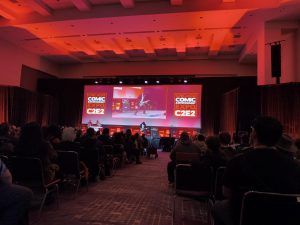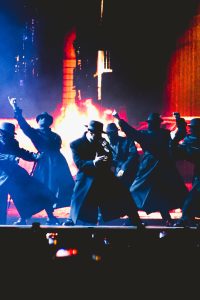The Chicago Wildfire set the sporting world ablaze
November 5, 2019
Since its inception in 2012, the American Ultimate Disc League (AUDL) has expanded from eight teams to its current 21-team format in an effort to penetrate the U.S.’s four-sport monopoly. The league, comprised of 18 U.S. franchises and three Canadian franchises, commences its season in the spring and concludes in the summer with a three-round playoff system which ends in a final four-style showdown known as the AUDL Championship Weekend.
The AUDL’s Chicago Wildfire were afforded the opportunity to showcase their brand before 62,306 fans against the Indianapolis AlleyCats during the halftime intermission of the Chicago Bears vs. New Orleans Saints game. The Wildfire came out on top, defeating the AlleyCats 4-3. More importantly, ultimate disc took center stage, gaining exposure for a budding sport eager to prove its merit under the brightest of lights.
The Chicago (formerly Windy City) Wildfire were founded in 2013. Since its inauguration, the franchise has been consistently competitive in the AUDL, participating in the 2013 AUDL Championship Weekend after a 14-2 regular season record and qualifying for the playoffs in three other seasons. I sat down with Jeremy Burril of the Chicago Wildfire to discuss his thoughts, aspirations and vision for ultimate disc.
Q: What is ultimate disc for those who are not familiar with the sport?
A: Ultimate frisbee is essentially a mixture between basketball and soccer all combined into one, except you play with a frisbee on a football-sized field. There are seven on the field for each team. Basically, you pass the frisbee between your teammates. If the disc at any point touches the ground or is intercepted by an opposing player play continues, and it goes the other direction and you are trying to score in an endzone. It’s a lot like basketball in the way that once you have the frisbee in your hand, you can’t run with it. You have a pivot foot that you have to keep on the ground. It’s a lot like soccer in the way that the disc moves, so you can move it in any direction. It’s a lot like the way that you’re trying to score in the endzone.
Q: Why is ultimate disc a sport more people should be tuning into and watching? What sets it apart from other sports?
A: I think what really sets the sport apart is that it is technically a non-contact sport. It is just like basketball–non-contact. There is a little bit of contact but there is not really supposed to be. So in that way it kind of eliminates a lot of concussion issues that a lot of other sports may have. I know football is under quite a bit of scrutiny because of their concussion issues. Our sport warrants just as exciting plays. It is incredible to watch people throw these frisbees. The amount of throws and distance people can get with a frisbee is just awesome to watch. It’s just a good experience for not only the players but also the spectators themselves.
Q: Where can people come to see the Chicago Wildfire play and get involved?
A: The Chicago Wildfire home field is at Langhorst Stadium in Elmhurst. It is actually at Elmhurst College. We have six home games between June and August.
Q: What was it like to showcase your talents at the Bear/Saints halftime show this past Sunday?
A: That was an absolutely incredible experience. Being in front of 60,000 people is something that very few things compare to or prepare you for, so it is awesome just to be out on that field in the first place. But then to be playing a sport that you love and be playing for a team you love is even better. It was incredible to interact with fans and see how excited they would get during our exhibition game. As little time as we had, I think we had a pretty good impact on those people. I actually live in Chicago. I live near Wrigley Field, so on my way home, I took the train and had people coming up to me saying that was the most exciting part of the game. They were asking about where we could get more, where they can buy jerseys, and just asking more about the game itself. It was truly incredible to see how just a short amount of time can have such a big impact on so many people.
Q: What response were you guys hoping for? Do you guys feel like you met that goal or do you guys feel that you actually exceeded it?
A: We were really just trying to entertain the people and show them that ultimate frisbee can be cool. A lot of people view ultimate frisbee as something that they did in gym class one time. A lot of times we’re confused for frisbee golf, so we wanted to show people that it is much different than frisbee golf. We are actually athletes. We run, we jump, we dive, we do all those kinds of things and I think we definitely hit those goals. We wanted to entertain people and have them asking, “Where can I get more of this?” I think [we] definitely hit that goal if not exceeded it.
Q: Your league expanded from eight teams to 21 in a relatively short period of time; I believe eight years, to be exact. How were you able to expand so rapidly?
A: That is a testament to the sport itself. There are facets of the sport, so it starts down in middle school. There are sixth and seventh graders that are playing so they grow up and there are high school teams, college teams, club level teams and ultimately professional teams. So I think just the growth of the sport itself warranted the expansion of those different teams.
Q: Do you think the AUDL doesn’t receive the same fanfare as other American sports teams? What do you think it will take to change that perception?
A: I think it is just going to be a matter of time. I think people are going to realize that we are just as exciting as these mainstream sports. It’s going to take some acceptance from other sports teams. I think once they see us on those Sportscenter Top Plays, once they see us [and] see the highlights of the sport, they’ll realize that it is really, really cool to see somebody going all out for a frisbee that you would have thought nobody could get near. I think it is just going to be about exposure.
Q: Do you think that the issues with the NFL and CTE will open the door for more non-contact sports?
A: Absolutely. That is already a main factor as to why a lot of people come over and play our sport. While it is still a dangerous thing to do because it is a sport, that’s just something that comes along with playing a sport, there is far less contact, or far less purposeful contact. That’s actually the main reason I came over and played this sport. I played baseball and football through high school and had to quit those because of concussions so that really strikes home with me. I think that’s going to be a huge building block for our league.
Q: What would you like to communicate to potential audiences, clientele and players that might want to invest in the sport?
A: I would say the one thing I want to give out to most people is to give it a try. Whether it is from a players’ perspective [or] from a fan’s perspective, come out to a game. See what the top-level players are doing and notice how exciting and fun it is. From a player standpoint, I did not think I was going to be a frisbee player let alone a professional frisbee player. But once you start playing the sport, once you start seeing the sport, seeing how exciting it is, it just becomes addictive. Once you give it a shot, you’re going to be hooked.
You can follow the AUDL on Facebook or Twitter (@theAUDL).







